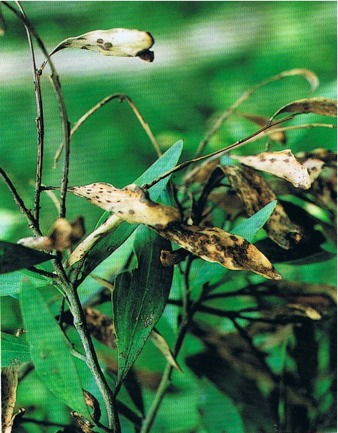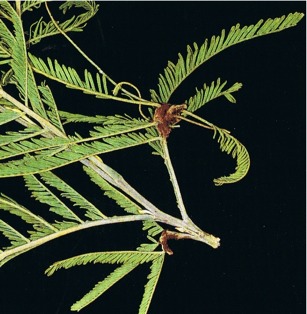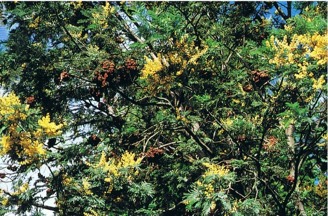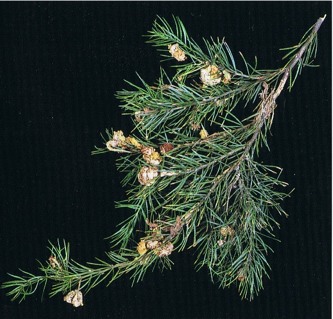PESTS AND DISEASES OF FORESTRY IN NEW ZEALAND
Acacia rust caused by Uromycladium spp.
Scion is the leading provider of forest-related knowledge in New Zealand
Formerly known as the Forest Research Institute, Scion has been a leader in research relating to forest health for over 50 years. The Rotorua-based Crown Research Institute continues to provide science that will protect all forests from damage caused by insect pests, pathogens and weeds. The information presented below arises from these research activities.
From Scion publication An Introduction to The Diseases of Forest and Amenity Trees in New Zealand,
Forest Research bulletin 220, G.S. Ridley and M.A. Dick 2001.
Rusts are a group of obligate parasites, belonging to the Basidiomycetes, that attack and live in only living plant tissue. Rusts may infect leaves or stems causing simple pustules, or induce large malformations and galls. As their spores are wind dispersed they can in some circumstances infect large areas relatively quickly. New Zealand is remarkably free of introduced tree rusts and this confers many advantages on plantation forestry. However, vigilance is required to maintain this status.
Species: Uromycladium robinsonii (Basidiomycete)
Common name: None
Country of origin: Australia
Host(s): Acacia melanoxylon
Symptoms:
Infection commonly occurs on phyllodes (Fig. 48), leaves, and petioles, and less commonly on twigs and small branches. Elongated, sunken, brown-black cankers up to 4 cm long are formed and they may girdle twigs, leading to dieback. Chestnut-brown powdery pustules containing urediniospores or teliospores, or both, are formed on the canker surface. The pustules frequently form circular groups up to 2 mm in diameter. Infection may cause dieback that contributes to multi-leadering and poor form.

Fig. 48: Uromycladium robinsonii lesions on the phyllodes of Acacia melanoxylon
Disease development:
Urediniospores and basidiospores are wind dispersed; however, infection requirements are not known.
NZ distribution:
Widespread in the North Island and recorded from Nelson and Christchurch in the South Island.
Economic impact:
First recorded in New Zealand in 1923, it is not common. Generally considered to be of minor importance but was once recorded as causing dieback of up to 80% of the crown in a 4-year-old plantation in Whakarewarewa Forest, Rotorua.
Table 3: Hosts and distribution of Uromycladium species
| U. acaciae (Fig. 49) |
U. alpinum | U. maritium | U. notabile (Fig. 50) |
U. robinsonii | U. simplex | U. tepperianum (Fig. 51) |
|
| Acacia baileyana | x | x | |||||
| A. dealbata | x | x | x | ||||
| A. decurrens | x | x | |||||
| A. longifolia var. longifolia | x | ||||||
| A. longifolia var. sophorae | x | ||||||
| A. mearnsii | x | x | x | x | |||
| A. paradoxa | x | x | |||||
| A. paramattensis | x | ||||||
| A. riceana | x | ||||||
| A. ulicifolia | x | ||||||
| A. verticillata | x | ||||||
| Distribution: | Throughout New Zealand | Throughout the North Island | Throughout the North Island. Also Lyttleton in the South Island. | Throughout New Zealand | Throughout New Zealand | Christchurch | Throughout New Zealand |
Control:
None available. There is potential for selection of resistant provenances, should this be deemed desirable.
History:
The Uromycladium rusts of Acacia species originate in Australia. All of the seven described species have been recorded in New Zealand. Some species have a very limited host range and others a very wide host range. Two species form large conspicuous galls on their host plants— U. notabile and U. tepperianum (Table 3).
In the 1920s, 1800 ha of A. decurrens were established for a tannin industry. The trees became so heavily infected with U. notabile that the plantations were cleared and the fledgling industry abandoned.

Fig. 49: Rust pustules of Uromycladium acaciae on the pinnules of Acacia mearnsii

Fig. 50: Stem galls caused by Uromycladium notabile on branches of Acacia dealbata

Fig. 51: Galls caused by Uromycladium tepperianum on twigs of Acacia riceana
This information is intended for general interest only. It is not intended to be a substitute for specific specialist advice on any matter and should not be relied on for that purpose. Scion will not be liable for any direct, indirect, incidental, special, consequential or exemplary damages, loss of profits, or any other intangible losses that result from using the information provided on this site.
(Scion is the trading name of the New Zealand Forest Research Institute Limited.)

 Farm Forestry New Zealand
Farm Forestry New Zealand

